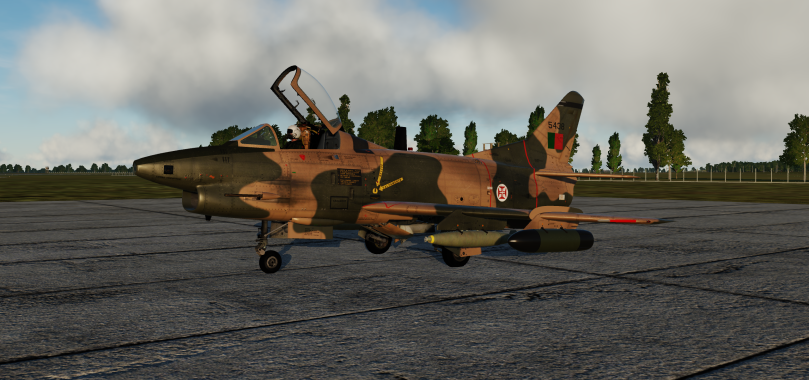The Frecce Tricolori Virtuali (FTV) are a group of passionate individuals that have dedicated themselves to both portray a virtual representation of the wonderful Italian Air Force team by the same name and to develop mods for a variety of games throughout the years like IL-2 1946, Lock-on and DCS.

After our review of the DCS MB-339 module, we reached out to the team of Frecce Tricolori Virtuali to conduct a series of interviews with them. One about their experiences as an acrobatics team and their history. Another about their projects, both released and upcoming such as the Fiat G.91, their know-how on module development within DCS and more!
FTV-Duke, Frecce's EFM developer, was our main point of contact during these interviews, so I want to extend my gratitude towards him for his great disposition while coordinating the interview.
What motivated the development of the MB-339 and how long was the process? Was it always planned to be released to the public or was it initially meant to be for private use by the FTV?
The development process for the MB-339 began by taking into account the strong needs of the Frecce Tricolori Virtuali to get their routines as real as it gets to their real counterparts the Frecce Tricolori.
First steps of the development were put in place in 2015, the same year the team transitioned from IL-2 Sturmovik 1946 to DCS World. The trial and error process started from taking already existent planes and features within the DCS World and adapting them to the needs of the team.
Finally, the team came to the conclusion that the efforts needed to be focused on the development of a brand new DCS World aircraft for private use, also considering the good feedback from the previous IL2 & Lock-on MB-339 (that were distributed for free to the public).
What went into creating the EFM for the mod? Did you guys have any official/unofficial documentation to help you in recreating the characteristics of the MB-339?
Recreating the EFM Model for the aircraft has been quite a challenge! It all started from data gathering such as performance manuals, to geometry and flight handling characteristics. Luckily enough, the MB-339 has quite a heritage on its shoulders and much information can be easily retrieved.
Second step would be the aerodynamics and stability of the aircraft as a whole. Once all the data has been collected, force and momentum equations have been written and coded into DCS for each of the flight conditions.
Despite what some could think, letting the aircraft behave in a decent way once on the ground has been without a doubt the hardest challenge. In fact, almost 6 months in the making for studying, coding and fine-tuning each of the many suspension coefficients for reaching the current ground feeling and behavior.
Given that this is a mod as non-third party developers, we could not access some of the information needed to speed up the development process and to lessen the frustration behind the inevitable trial and error phase.
The third step is represented by testing the now usable jet in every possible condition by both real pilots and the entire Frecce Tricolori Virtuali Team. The multitude of important feedback through the months of testing helped in increasing the fidelity by furtherly fine-tuning the model to get to the current status that you could enjoy.

What was the point that made you guys switch from an SFM to an EFM? Was the SFM interfering with the team’s ability to do proper formation flying?
Going from the SFM to the EFM has been a critical and mandatory step for bringing the needed performance to the team. Being that the routine encompasses many extreme envelope maneuvers (especially considering the solo pilot) the SFM would only let the aircraft adhere to a believable behavior close to the nominal flying conditions (slow change aerodynamic conditions – possible only for the formation flying – and not always).
The EFM allowed the aircraft to stretch its wing to the outer borders of the real envelope, having then an almost identical performance in the nominal state, but also being able to represent in an acceptable way some extreme envelope conditions.
A well-coded engine model has also been crucial for a proper formation flying, engine spool up and overall response has been tuned to reflect the real MB-339. The acceleration time has been modeled as the real one by having a high responsive engine in the range 70-100 % which allows better formation flying characteristics.
Was it hard getting the multi crew feature working on the mod? What went into implementing it?
Adding the multicrew to the MB-339 has not been hard, few lines of code needed to be implemented in the configuration file.
On the contrary, it will be much harder to visually synchronize the front and back seat instrumentations and aircraft systems which require a dedicated net code.
Are there any features left to be implemented on the MB-339?
The current version (2.0.1) of the MB-339 features simplified systems (LUA-coded) to have a flyable aircraft from the beginning.
After the release of the 2.0.1 the team dedicated to the complete re-coding in C++ by starting over and modelling system by system and also subsystem to achieve the best possible realism. Starting from the next release, the electrical system will be an advanced one (different buses, loads), oxygen and pressurization system acting as the manual prescribes. In addition, a new fuel system is being developed (with fuel dumps, transfer etc…) a new navigation system and a new damage model plus minor features that will get the MB-339 on to a new level.
The cockpit 3D model has been updated and the textures as well with a new restyling to augment the graphical impact.
We have seen your screenshots from your most recent job, the Fiat G-91. How has the progress been with that aircraft? How many people are working on the project?
The G-91 derives from a joint collaboration with Sim Skunk Works that shares passion and dedication for this bird. This has also been the time to test the import in DCS and its graphical rendering.
The team eventually fell in love with the model and the aircraft that has also starred in an Italian Movie from 1972 named “Forza G” (literally “G-Force”) representing those mighty years at the Frecce Tricolori, with an exceptional soundtrack by Ennio Morricone.
Currently the project encompasses the same developers that work on the MB-339 plus one 3D modeler from the Sim Skunk Works, creator of the original 3D model itself.
Despite the aircraft being flyable in DCS as we speak (it closed the performance at the Virtual Burning Lake Airshow 2020), currently the aircraft is undergoing some work in the external and internal (cockpit) 3D model to get it to the DCS standard.
How has the G.91 been in terms of difficulty of development? What weapon systems and avionics equipment will the team implement since there are different versions of the aircraft (R1, R3 and PAN in particular)?
Currently the team has all the 3 variants’ model, as far as the cockpit is concerned, only the R1 version is ready.
Speaking about the avionics and systems the aircraft is comparable to the MB-339, being developed for reconnaissance and ground attack missions, it has no radar and countermeasures.
This will allow the team to use a large part of the work from the MB-339 and be tailored to the G-91.
The aircraft now has guns, free fall bombs and rockets implemented, but we would like to expand its ground attack capabilities (e.g. to add air to surface missiles like the AS-20).
In-development pictures of the Fiat G.91 module as of May 2020.
Can we expect a public release for the G.91 or is it going to be a private mod for the Frecce Tricolori Virtuali?
The idea of releasing the model to the public is very attractive. However, both the FTV and SSW need first to define some terms.

We heard the news about some of the team’s involvement as “insiders” for Microsoft’s Flight Simulator and saw the possibility of having the MB-339 inside of that spectacular game as a possibility. Will this affect the development of the G.91 and other DCS projects in the long-term or is there nothing to worry about?
FS2020 is absolutely spectacular in terms of scenery and graphics and has progressed a lot since the previous version. The team has internally started to discuss a future inclusion of the MB-339 in the new MS FS2020 and we really look forward to it and the possibility to start some tests. It is too soon to say something about possible delays on other long term projects but from the first impressions, we think we are capable of creating the MB-339 for the new FS.
Apart from finishing your current mods do you have any other future aircraft you would like to work on such as the AMX?
The team is absolutely eager to continue on developing other Italian Air Force aircraft such as the AMX, but given the effort for the current project we cannot take on new commitments.
This is part one of two from our interview with the Frecce Tricolori Virtuali. The next part will be all about their organization, their history and their acrobatic routines. We would like to extend our thanks to the entire team of the FTV that treated me kindly and were really attentive and generous with this interview, specially FTV-Duke.
About the Interviewer
Santiago "Cubeboy" Cuberos

Longtime aviation fanatic with particular preference towards military aviation and its history. Said interests date back to the early 2000's leading into his livelong dive into civil and combat flight simulators. He has been involved in a few communities but only started being active around the mid 2010's. Joined as a Spanish to English translator in 2017, he has been active as a writer and content manager ever since. Twitter | Discord: Cubeboy #9034








































.png)